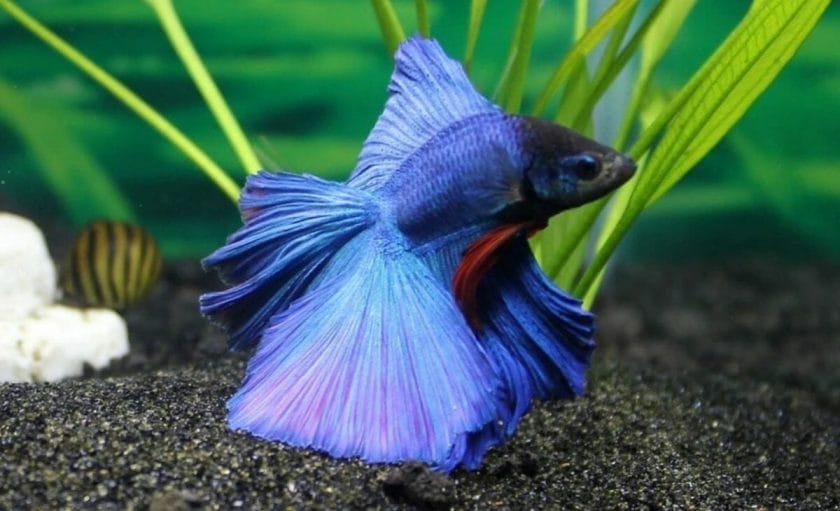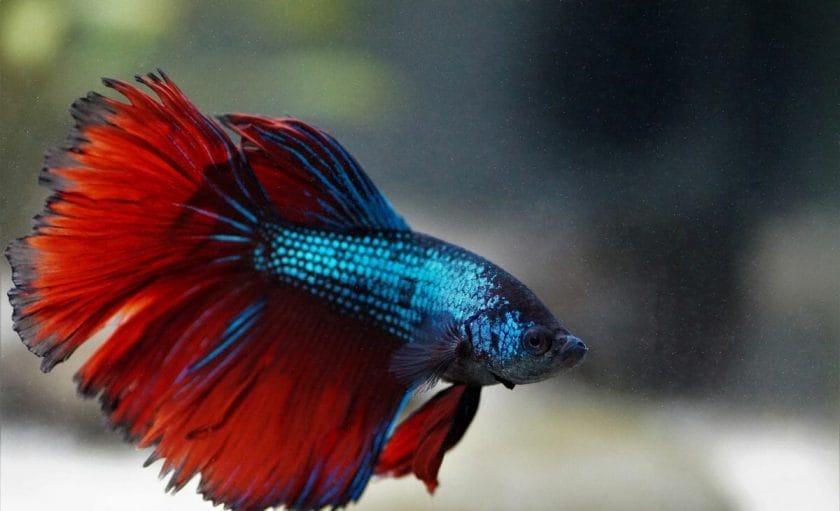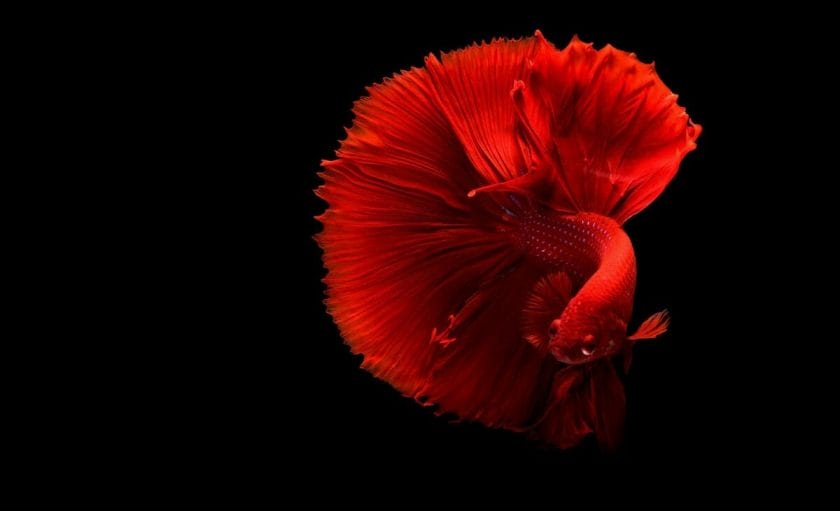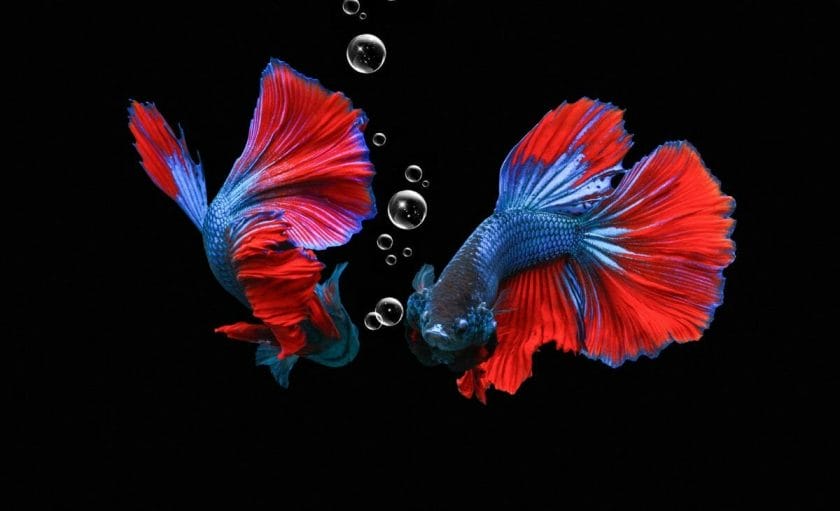Are you wondering how to improve your betta fish’s color? You’ve come to the right place!
In this article, I’m going to give you six simple tips to help you ensure your Betta is looking its brightest.

Table of Contents
1. Feed Your Betta a Variety of High-quality Food

Your betta’s diet can greatly impact how colorful they are. Their diet must be high in protein and contain various foods rich in essential vitamins and minerals.
Their colors can fade or wash out if they don’t get enough of the right nutrients.
It’s best if your fish’s diet contains a mix of prepared foods (like flakes or pellets) and frozen/freeze-dried foods. However, frozen food is more nutritious than freeze-dried food.
The best prepared foods are those that are high in vitamins and contain probiotics.
You want to avoid products that have a lot of artificial additives and make sure they’re made with whole foods.
For frozen or freeze-dried foods, you can feed them various aquatic life as long as it will fit in their mouth. Freeze-dried or frozen bloodworms are very popular among aquarists, as most fish love them, and they’re nutritious.
You can also be sure that frozen fish food doesn’t have any bad bacteria or parasites attached to it.
The best color-enhancing foods to give your fish are any kind of crustaceans.
Crustaceans contain carotenoids, which improve your fish’s color. Some good crustaceans to feed your fish include brine shrimp, krill, daphnia, and cyclops. You can get these frozen or freeze-dried.
Spirulina is another good thing to add to your fish’s diet. It’s a type of algae that is good for your fish and is known to boost its color.
Many fish won’t eat spirulina by itself. You can get fish flakes, pellets, and frozen/freeze-dried foods with spirulina added.
Putting all of this together, here is a healthy feeding schedule for a varied diet:
- Feed your fish 1-2 times a day. Most fish are happy with one feeding a day.
- Every other day, you can feed your fish some frozen or freeze-dried food, alternating with different kinds every so often. The rest of the time, you can feed them flakes.
- Frozen food doesn’t need to be thawed out before adding it to your tank; it will melt.
- Only feed your fish what it can eat in 2-5 minutes, and make sure you remove any leftover food.
2. Keep Your Betta’s Tank Clean

We all know how stressful it feels to live in an unclean environment. That’s why most of us clean continuously throughout the day.
Well, your fish’s environment is no different. Fish become stressed and unhealthy in a dirty environment, so keeping it clean is essential.
When fish become stressed or unhealthy, their colors can fade or be lost completely.
One of the most important things to do for your fish is change the water. You should do this once a week.
You may be able to do it less depending on your tank size, how many fish you have, your filter size, and how many live plants you keep in the tank.
Changing the water in your tank is essential as it helps reduce ammonia, nitrites, and nitrates, which are harmful to your fish.
Having too much of these present in the tank will stress your fish, and it can even be deadly.
You should change at most 25% of the water at a time. But doing smaller changes more frequently would cause the least amount of stress to your fish.
To change your tank’s water, all you need to do is use a gravel siphon and suck out the portion of water you intend to change, and transfer it to a bucket.
Now dump out the old water and clean the bucket. Put fresh, clean water into the bucket. Treat the new water with any water conditioners or dechlorinators you need, and then add the new water to your tank gently.
You’ll also want to clean algae and vacuum debris within the tank as needed. This can be as often as every day or once a week.
Whenever you see algae starting to build up, you should clean it with an algae scrubber. And if you notice any particles or debris floating around the tank or at the bottom, you should use the gravel siphon to vacuum it up.
This will ensure your aquarium is nice and healthy for your fish.
3. Add Some Tannin to Your Betta Tank

Tannins occur naturally in many parts of trees. It helps protect them from fungal or bacterial infections and can do the same for your fish once it’s added to the water.
Tannins will also lower the pH in aquariums, so keep this in mind.
Tannins don’t directly help improve your Betta’s color. It darkens your aquarium’s water, which makes your fish stand out and appear more colorful and vibrant.
You can get tannin extracts from most pet stores. They’ll be advertised as some kind of leaf extract, so you’ll have to check the ingredients to know if it’s tannin.
4. Keep Your Betta Tank In Ideal Conditions

Keeping your fish in its ideal environment will give it its best quality of life and make it happier. The happier and more comfortable a betta is, the more likely it is to show brighter colors.
Tank size
Although you can keep a betta in as little as 2.5 gallons, it’s not ideal. They won’t be as happy as they would be in a bigger tank.
Fish come from bodies of water much larger than these puny tanks, so biologically, they prefer as much water as you can give them.
I wouldn’t go any smaller than a 5-gallon tank for their optimal health and happiness.
Water temperature
Temperature also has a role to play in your fish’s contentment. The temperature inside the aquarium should always remain between 75℉ and 80℉ for your fish to be happy.
They can survive lower temperatures and still live well, but they won’t be as happy or healthy as they would be at the proper temperatures.
Here’s the table showing different water parameters and the ideal ranges for Betta fish
| WATER PARAMETERS | VALUES |
|---|---|
| WATER TEMPERATURE | 77° and 86° F |
| WATER pH | 6 – 7.5 |
| WATER HARDNESS | 5° to 20° dH |
| AMMONIA | 0 PPM |
| NITRITE | 0 PPM |
| NITRATE | Below 40 ppm |
Oxygen
Make sure your fish always has enough oxygen. Water movement is a common way to increase oxygenation and aeration. Filters, air pumps, air stones, or manual movement all increase the amount of oxygen in the water.
You can also add live plants to your aquarium as they produce oxygen.
Keeping your fish in its ideal condition can help improve its color because it will be healthier and happier, directly affecting how its colors appear.
Fish want to live in an environment as close to their natural one as possible.
That’s why temperature, water volume, and water quality need to meet certain standards regarding your pet’s overall health and happiness.
5. Avoid Stressing Your Betta

Fish can very easily get stressed out because of how sensitive they are. Stress plays a role in not only their health but also their happiness.
A stressed fish could lose their color or cause it to dull.
Here’s a list of things you can do (or stop doing) to keep your betta from stressing out:
1. Don’t Overcrowd Them
I know how exciting it is to start a new tank and then want to fill it up with as many fish as you possibly can. But you have to keep in mind the size of your tank.
Is your fish social, or do they prefer to be alone? Bettas, in particular, usually like to be alone and can even be aggressive toward some kinds of fish.
Think of your fish like it’s a human. Most people get stressed, anxious, or tired after being around too many people in a confined space.
2. Only Put Them With Appropriate Tank Mates
When it comes to bettas, adding a new tank member can be scary. If they don’t get along, one of them could get seriously hurt or die.
Bettas are notorious for not playing well with others and will only tolerate certain fish in their space.
If you add another fish in with your betta, make sure your tank is at least 10-20 gallons, or they may try to attack the other fish.
This is because betta fish are very territorial. If they don’t have plenty of space to claim as their own, they’ll fight the other fish for it.
Here are some fish that are usually safe to put with bettas:
- Corydoras Catfish
- Neon Tetras
- Molly Fish
- Endler’s Livebearers
- Honey Gourami
- Chili Rasbora
- Otocinclus Catfish
- African Dwarf Frogs
- Bristlenose Pleco
Here are some fish you’ll want to steer clear of:
- Angelfish
- Silvertip Tetras
- Cichlids
- Black Skirt Tetras
- Tiger Barbs
- Serpae Tetras
- Goldfish
Overall, you’ll want to make sure that there’s enough space for your betta and
any tank mates. Make sure you only add peaceful and smaller-sized fish with your
betta.
Remember, you should never keep male bettas with other betta fish. Female
bettas may be able to be kept together, but it’s tricky.
Putting your betta with the wrong fish can cause them a lot of stress.
Make sure to do your research if you’re questioning whether a certain fish will
be okay with your betta.
Every fish is different. Assess your betta’s personality before deciding if a new
tank mate would be best.
3. Don’t Move Them Around Too Much
Fish get stressed when their environment changes. The more it changes, the more stressed they are.
It’s best to find a good spot for them and leave them there for as long as you can.
This also applies to other changes like plants or decor. Avoid changing the decor or plants inside your aquarium too much.
4. Do Smaller Water Changes At A Time
As previously mentioned, bettas don’t like a lot of change. And that includes water changes.
They are essential to keeping your fish healthy, yet if we do it the wrong way, it can stress them out.
Smaller, more frequent water changes are best to keep your fish stress-free.
5. Add New Tank Mates Properly
If you’re going to add a new tank mate for your betta, you should do it in a way that will cause the least amount of stress for all fish involved.
1. Quarantine
The first thing you’ll want to do is quarantine your new fish. You may not need to do this if you get your fish from a trustworthy source.
This is done to prevent potential diseases or parasites from affecting your other fish. It also helps your new fish acclimate to the new environment.
To quarantine a fish, you’ll need a separate quarantine tank. Make sure it’s suitable for the type of fish that will be staying in it.
Make the quarantine tank’s environment as similar to your main tank as possible.
You’ll want to take as much water from your main tank as possible and put it into the quarantine tank. Fill it up the rest of the way with new, clean water.
You should use an already cycled filter for the quarantine tank or borrow some substrate from your main tank that already has some good bacteria.
Keep temperatures and water parameters as similar as possible to the main tank.
Keep the fish in quarantine for 2-6 weeks. Watch them carefully to notice any signs or symptoms they may have.
You can give them preventive medications if you deem it necessary, but this can be stressful for the fish.
2. Acclimate The New Fish
After quarantining, you should acclimate your new fish to the tank you intend to keep them in.
If you were able to quarantine your new fish in similar water parameters and temperatures to your main tank, you might not need to acclimate your new fish.
To acclimate a fish, you can slowly add some of the tank water to the container it’s currently in. Let it sit for at least 30 minutes.
If your new fish came in a bag and you aren’t going to quarantine it, you can set the bag in the tank and allow it to float on the top.
The temperature inside the bag will slowly rise or fall to the tank’s temperature.
3. Remove Your Betta
Before adding the new fish to the aquarium, remove your betta from the tank.
It will get aggressive if it feels like the new fish is trespassing on its territory. Remove the betta into a temporary container.
Once the betta is gone, add the new acclimated fish to the aquarium. Let him swim around and get used to it for a while.
Turning the light off during this process will help keep your fish from getting stressed.
As soon as the new fish looks settled, you can add the betta back into your tank. It may chase or try to nibble at the new fish, but that behavior should eventually pass.
6. Provide A Peaceful Environment for Your Betta Fish

A peaceful environment will make sure your fish remain happy and stress-free. If your fish is stressed, its colors can fade and disappear. Sometimes permanently.
That’s why it’s important to keep them happy!
Adding plants to their tank can help make them feel more at home since it mimics their natural environment.
Not only that, but plants also help oxygenate the water and remove harmful toxins from the water.
Another thing to consider is lighting. Too much or too little light can cause problems.
Not enough light can cause your betta to lose its color. But too much light is stressful for the fish.
A good rule of thumb is to give your betta a day and night cycle, just like us. You could turn the light off in the evening and turn it back on in the morning.
Alternatively, you can give your betta 8-12 hours of light and 12-16 hours of darkness per day.
You should avoid putting the tank somewhere where it’ll get a lot of direct sunlight. This increases algae growth, and the light could be too intense for your fish.
Something most fish can benefit from is hiding spots. It’s a natural instinct for fish to want to hide when they feel threatened or unsafe.
Because of this, they’ll feel very uncomfortable in a tank that doesn’t provide any cover or caves.
Knowing they have somewhere to go that’s just their own will help them stay happy and stress-free.
Most fish prefer thick foliage plants, and some like caves as well. A combination of both would be best.
FAQ

Why Is My Betta Fish Losing Its Color?
Betta fish can lose their color for several reasons.
Stress is one of the most common reasons betta fish begin to lose color. Betta fish are especially susceptible to stress, which can cause various health risks and color loss.
Another common reason is old age. As betta fish age, their colors can fade or be lost altogether. Unfortunately, there isn’t much you can do about this.
A betta’s environment can have a big impact on its colors. Temperatures that are too cold can cause colors to be muted, and temperatures that are too hot can make them brighter.
But you should always try to keep their temperatures between 75℉ and 80℉.
Water quality also plays a role. If your fish live in bad conditions, they will become stressed, likely resulting in color loss.
The overall health of your fish determines how bright or dull their colors are. If your fish is healthy and happy, its colors will be vibrant and bright. If it’s not, they’ll appear dull or nonexistent.
If your fish has an infection, disease, or parasite, it may cause its colors to dull or disappear completely.
Diet is a big factor in this as well. If your fish only eats flakes, it may lack some nutrients that make its colors brighter.
Fish prefer a varied diet, and it’s better for them. Give them a combination of prepared foods and frozen foods for optimal health.
Can Betta Fish Change Colors?
Yes, betta fish can change colors.
Stress, health conditions, and old age can all cause a betta to change from one color to another. But it’s usually very gradual.
There are some betta fish that have the jumping marble gene. A betta with this gene could have multiple dramatic color changes throughout its life and still be perfectly healthy.
Conclusion
To improve the color of your betta fish, keep them healthy, happy, and stress-free. Avoid drastically changing their environment and feed them a varied diet.
Make sure you keep your betta fish in its ideal conditions, as mentioned above, to keep them vibrant and happy.
I hope this list has helped you on your fish-keeping journey!